Decades after her death in 1999, Belkis Ayón’s body of work found greater interest in the modern art world.The collections root themselves in Cuban legends while remaining bound by its contemporary socio-economic climate. Her artworks, striking and strange, present a mythology unseen by most.
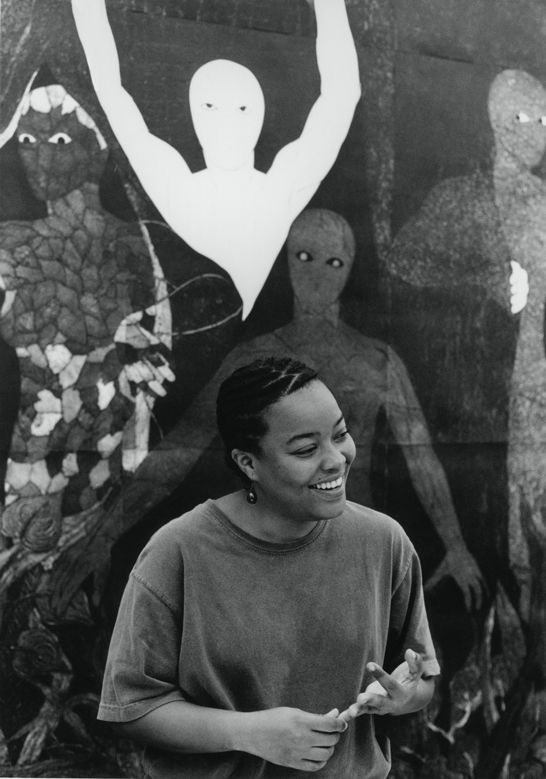
Ayón’s work uses collagraphy — an unconventional artform from her home country, Cuba, where she lived and died. Collagraphy, a printing process, collages a number of materials into a cardboard cast and runs it through a press. Using a manual printing press, Ayón cranked out her mysterious designs onto paper by hand.
While the artworks speak to a spiritual realm, Ayón laboured over its depiction with a technique born out of necessity. The dissolution of the Soviet Union plunged Cuba into nationwide poverty, leaving traditional art materials in short supply amongst food shortages and sky-high petrol prices.
Yet, Ayón's work transcends her circumstances even as she embraces her material limitations.
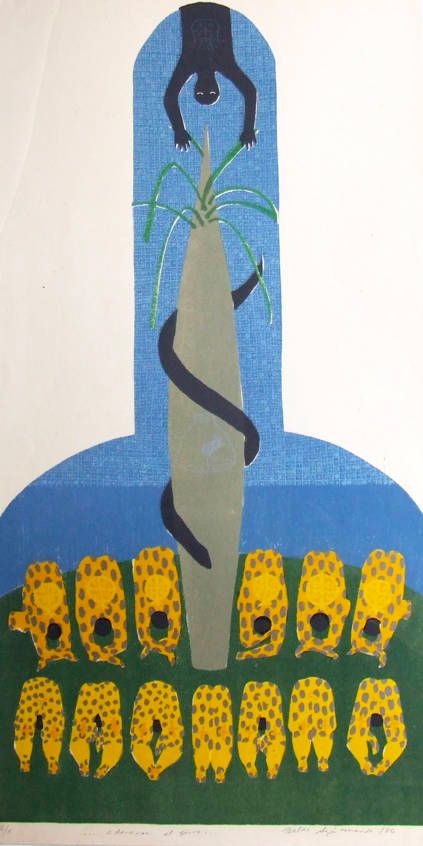
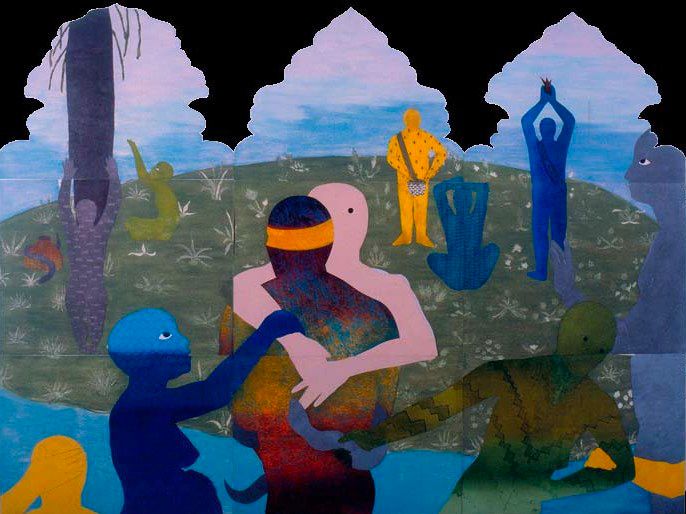
Ayón, like other Cuban artists at the time, questions and critiques the fall of a socio-economic structure and the ethical principles hinged on it. In its attention to her Cuban heritage, Ayón’s body of work aids towards the United Nations Sustainable Development Goals of Reduced Inequalities.
Ayón’s prints dared to venture into the the uncharted part of her Cuban identity, namely the Abakuá, an all-male Cuban secret society. The Abakuá traces back to the Africans taken and enslaved from the Cross River region of Nigeria. Since their shipment to Cuba's port cities in the early nineteenth century, the Abakuá brotherhood has existed as a refuge and resistance for all within it.
Ayón imprints Abakuá mythology into cardboard. With dynamic patterns and forms that remain static, the artist creates a stillness that appears strangely alive. Later in her career, the stark contrast of values in Ayón’s distinctive works — the varying greys, whites and blacks — arouse a spectral, otherworldly feeling.
Featureless, androgenous figures wander through the open spaces of her work. These formless figures move in between time and space; their lack of clothing, skin or defining facial features bind them to no known history or people. Their only defining characteristics are their bright, almond-shaped eyes, bearing witness to the audience with an uncanny intimacy.
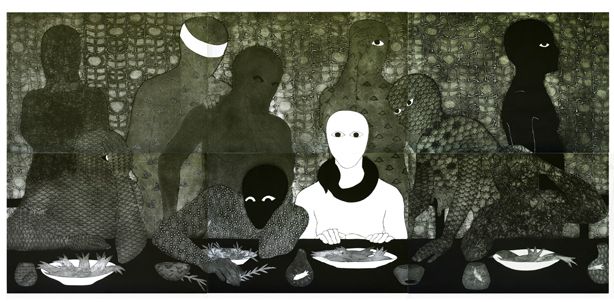
Women remain on the outside of the secret brotherhood of Abakuá. But, they are there, on the inside as the secret. The legend of the Abakuá begins with a woman, Princess Sikán. While drawing water from the river, Sikán heard the voice of the Abakuá bellow from a fish. The fish, the incarnate of an old clairvoyant king, becomes a symbol of wealth and power. Yet even in myth, women were barred from this secret knowledge. Sworn to secrecy by a local diviner, Sikán was sentenced to death when she shared her knowledge with her beloved. Nevertheless, Sikán continues to live in Ayón’s art.
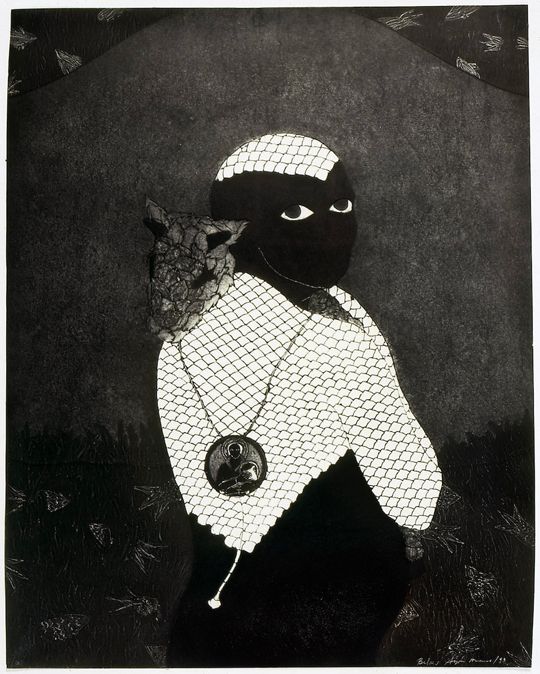
In an untitled piece, referred to as Sikán with Goat, Sikán shields her pregnant belly from the viewer, save for a slight outline of her bump. Peering over her shoulder, Sikán’s wide-eyed gaze catches one's own, leaving the viewer unable to look away.
Ambiguity haunts the piece — the goat is but one example, with its patterned skin that could be of a fish or a snake. While Ayón's work presents gender as another ambiguity, her work explores femininity rather than feminism. Still, Ayón details the subtleties of power imbalances.
“The mystery of the legend in itself,” says Ayón in an interview with La Gaceta de Cuba magazine, “how hidden some of their meanings have been throughout history is what has, in fact, has given me the opportunity to make certain speculations, but my position has never been to reproach the Abakuá brotherhood, but on the contrary, to show respect and to disseminate it in its broader cultural sense.”
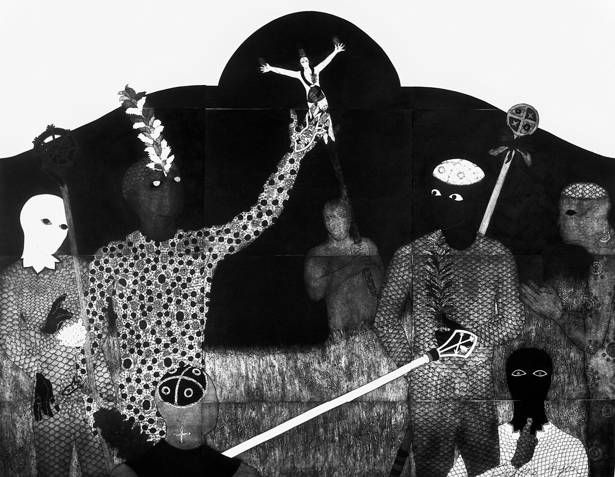
The span of Ayón’s themes — love, devotion, loss, self-sacrifice, and betrayal — and the intensity of her imagery allude to the artist’s curiosity beyond the confines of the secret society. Rather than narrate its socio-political commentary, Ayón finds counsel in the emotional and psychological embodiments of the Abakuá myths. Sikán becomes a figure of Ayón’s own existential uncertainty and sense of self.
Explaining her faceless characters to Revolución y Cultura Magazine, Ayón said, “[p]erhaps my work is that: these are things I have inside and that I toss them out because there are burdens with which you cannot live or drag along.”
The legends of the Abakuá become the personal mythology of Ayón, caught between reality and folktale. Ayón, in foregrounding herself as the princess, becomes the creator sacrificed for the creation. Within her images of the Abakuá, the secret lives on, and so do its women.
Find more of Akon’s work here.
